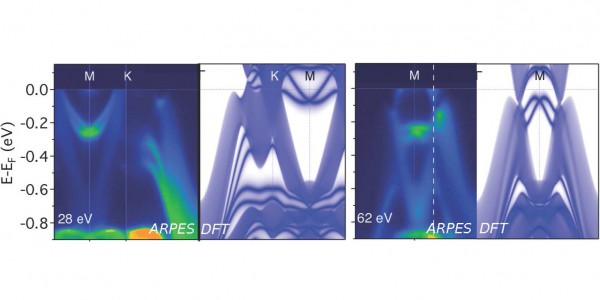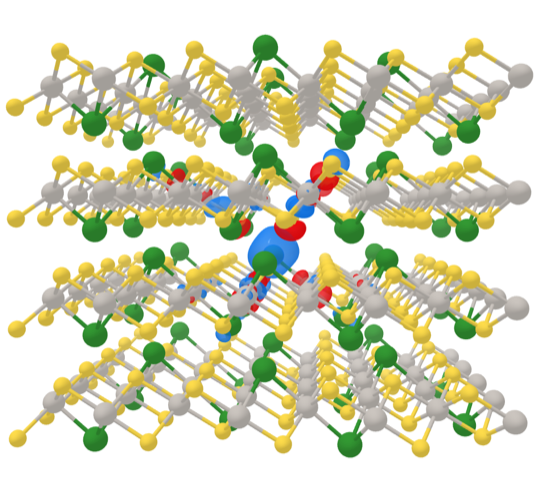New experimental and theoretical evidence identifies jacutingaite as a dual-topology insulator
by Carey Sargent, NCCR MARVEL, EPFL
Topological insulators (TIs) are bulk insulating materials that nonetheless exhibit metallic conductivity on their surfaces. This conductivity is guaranteed by the bulk band structure’s topology—the surface features these states as long as the symmetry defining the topological index remains the same.
In so-called strong TIs, these states are protected and so featured on all surfaces. In weak TIs however, these properties are only protected at surfaces with a certain orientation. Stacking two-dimensional TIs, that is QSHIs, to form a three-dimensional crystal, for example, generally produces a weak TI with no protected states on the top or bottom surfaces of the crystal: there are metallic surface states inherited from the edge states of the 2D TI, but also an insulating surface plane that lies normal to the stacking direction.
Recent theoretical work, also carried out by MARVEL researchers, suggested however that this might not be the case for stacked, or bulk, jacutingaite. The research suggested a more complicated scenario—the material may be a topological crystalline insulator (TCI) as well as a weak TI. In TCIs, the topology is defined by symmetry with respect to a mirror plane and metallic surface states can be found on surfaces perpendicular to it. This state might be expected in the material because of it threefold mirror symmetry. Jacutingaite also maintains translational symmetry in the stacking of the layers though, meaning that it might also feature the properties of a weak TI. Until now, however, there have been no experimental results on the bulk band structure.
Research initiated by EPFL’s THEOS lab and carried out in collaboration with the Department of Quantum Matter Physics at the University of Geneva and other groups including the Diamond Light Source in the UK, has now however described the first ever synthesis of a single crystal of jacutingaite and used the sample to provide evidence for their dual-topological nature by comparing the bulk and surface electronic structure determined from synchrotron-based angle-resolved photoemission (ARPES) experiments with DFT calculations. The paper, Bulk and Surface Electronic Structure of the Dual-Topology Semimetal Pt2HgSe3, has recently been published in Physical Review Letters.
The work revealed topologically-protected surface states in the natural cleavage plane (001) of the material, unexpected as it should rather support a weak topological phase since it is a stack of 2D QSHIs. Calculations of certain topological invariants confirmed the weak topological insulator phase generally characterized by gapless modes on the lateral surfaces, but fully gapped states on the top and bottom surfaces. The surface states found on the 001 surface were therefore assumed to be the manifestation of a different topological phase.

Figure 1: Comparison between the experimental ARPES data and the simulated (DFT) surface spectral density, the sharp features with linear crossings at the point M correspond to surface states.
The researchers hypothesized that it might be an indication of the TCI phase associated with the threefold mirror symmetry of the crystal. In such a case, topologically protected surface states are expected on crystal surfaces that preserve the mirror symmetry and this was the case for the cleaved (001) surface.
Using first principles calculations, the researchers were able to identify this surface state as the signature of a TCI phase that coexists with the generic WTI phase found in the same calculations. The results thus provide evidence for the predicted dual topology of Pt2HgSe3. What remained unclear however is the mechanism behind jacutingaite’s status as a dual topological insulator.
This very topic was addressed in theoretical work developed at EPFL’s THEOS, research that complemented the experimental and computational work carried out in the other paper. In the paper Emergent dual topology in the three-dimensional Kane-Mele Pt2HgSe3, researchers Antimo Marrazzo, Nicola Marzari, and colleague Marco Gibertini at the University of Geneva, formerly of THEOS, extended the two-dimensional Kane-Mele (KM) model used to describe topological materials to bulk jacutingaite. The paper was recently published in Physical Review Research.
They showed that the unexpected topology in bulk jacutingaite comes from a strong interlayer hybridization that leads to a 3D generalization of the KM model. While nearest layers are almost decoupled, there is a large, peculiar hopping term that indicates strong coupling between layers that are two layers apart. Even and odd layers are then more or less independent and can be separately described by a 3D KM model, dubbed J3KM in the paper, that includes a band inversion driven by this novel hopping term. This results in a nodal line that is gapped by spin-orbit coupling and a nonzero Chern number—that is, protected surface states consistent with TCIs. When coupling between even and odd layers is restored though, the material again acts as a WTI.

Figure 2: Crystal structure of bulk jacutingaite (Pt2HgSe3), in red and blue one of the two maximally-localised Wannier functions underlying the J3KM tight-binding model.
This insight provides a microscopic understanding of the emergent dual topology of the material. The J3KM model predicts the presence of surface states and nodal lines gapped by spin-orbit interactions, in agreement with the ARPES measurements and first-principles simulations carried out in the other paper. The model is relevant for all other layered materials made of stacked honeycomb lattices and provides an appealing strategy for breaking the standard paradigm of weak topological insulators.
Finally, the combination of the experimental evidence, first-principles simulations and theoretical models on 3D jacutingaite supports THEOS’s earlier prediction that 2D jacutingaite is a Kane-Mele (graphene-like) quantum spin Hall insulator.
References:
Bulk and Surface Electronic Structure of the Dual-Topology Semimetal Pt2HgSe3 , I. Cucchi, A. Marrazzo, E. Cappelli, S. Riccò, F. Y. Bruno, S. Lisi, M. Hoesch, T. K. Kim, C. Cacho, C. Besnard, E. Giannini, N. Marzari, M. Gibertini, F. Baumberger, and A. Tamai, Phys. Rev. Lett. 124, 106402 – Published 13 March 2020
Emergent dual topology in the three-dimensional Kane-Mele Pt2HgSe3, Antimo Marrazzo, Nicola Marzari, and Marco Gibertini, Phys. Rev. Research 2, 012063(R) – Published 13 March 2020
Low-volume newsletters, targeted to the scientific and industrial communities.
Subscribe to our newsletter